有机化学双语课件Chpt_1
- 格式:pdf
- 大小:549.15 KB
- 文档页数:10
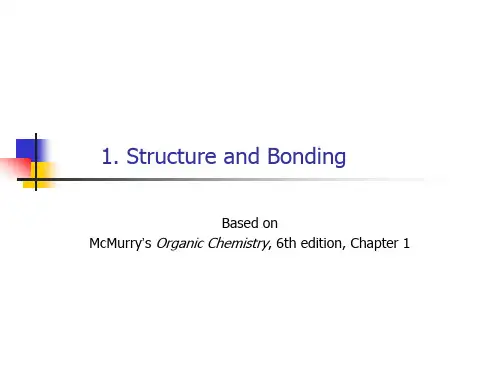
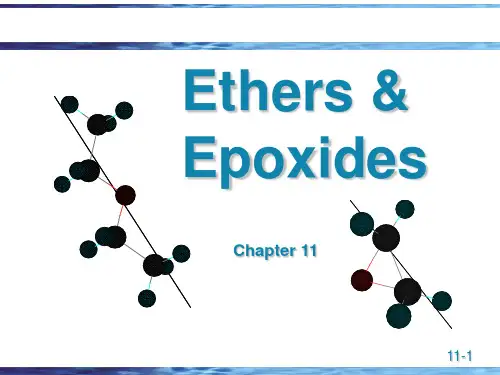
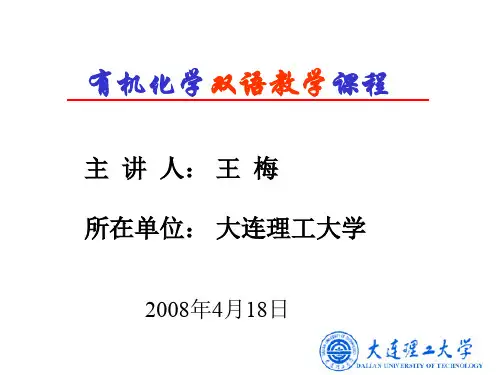
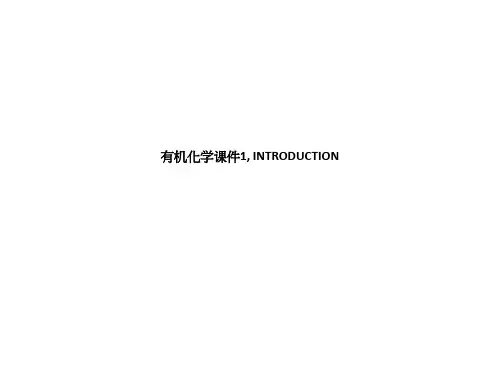
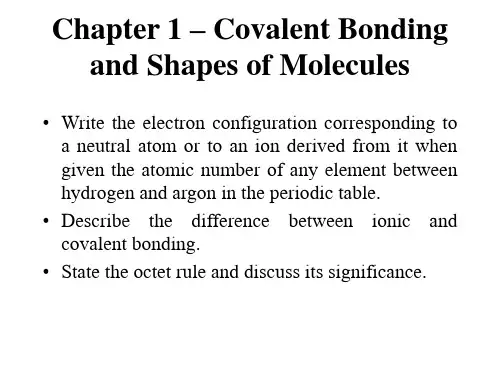




有机化学ppt课件完整版目录•绪论•有机化合物的结构与性质•烃类化合物•烃的衍生物•有机合成与反应机理•生物活性有机化合物绪论碳氢化合物研究碳氢化合物(烃)的结构、性质、合成和反应机理。
碳氢化合物的衍生物研究烃的衍生物,如醇、醛、酮、羧酸、酯等有机化合物的结构、性质、合成和反应机理。
生命体系中的有机化合物研究生物体内的氨基酸、蛋白质、核酸、多糖等生命物质的结构、性质和功能。
经典时期19世纪初到20世纪初,以经验规律为指导,通过大量的实验总结出了许多有机化学的基本概念和原理。
萌芽时期从远古时期到18世纪,人们开始使用天然有机物,如木材、植物、动物等。
现代时期20世纪至今,以量子力学和统计力学为基础,发展出了现代有机化学的理论和方法,如分子轨道理论、价键理论、反应机理理论等。
环境领域有机化学在环境保护方面发挥着重要作用,如研究大气污染物、水体污染物的来源和治理方法等。
同时,有机化学也致力于开发环保材料和清洁能源。
材料领域合成纤维、塑料、橡胶等高分子材料广泛应用于服装、家居用品、交通工具等领域。
医药领域合成药物如抗生素、抗癌药物等对于治疗疾病具有重要意义。
同时,天然药物中提取的有效成分也是有机化学的研究对象。
农业领域合成农药和化肥对于提高农作物产量具有重要作用。
此外,生物农药和生物肥料的研发也需要有机化学的支持。
有机化学与生产生活的关系有机化合物的结构与性质碳原子通过四个共价键与其他原子或基团相连,形成复杂的有机分子结构。
碳原子的四价性键的极性空间构型碳原子与其他原子形成的共价键具有不同的极性,影响有机物的物理和化学性质。
有机化合物分子中的原子或基团在空间的排列方式不同,导致同分异构现象的产生。
030201有机化合物的结构特点03同分异构体的性质差异由于结构上的差异,同分异构体在物理性质、化学性质以及生物活性等方面表现出明显的不同。
01构造异构分子式相同但连接方式不同,如正丁烷和异丁烷。
02立体异构分子式相同、连接方式也相同,但空间构型不同,如顺反异构、对映异构等。
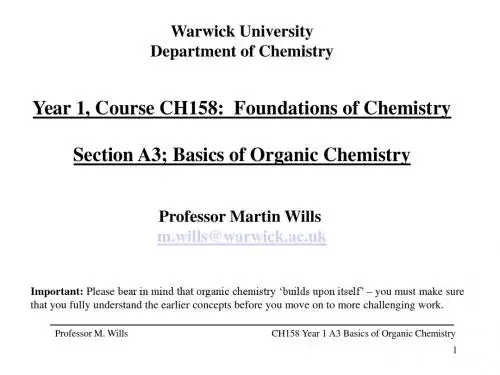

•Wöhler’s Synthesis of Urea:
•Synthesis –Construct complex organic chemicals from simpler, more readily available ones (Chapter 8).
covalent bond is formed.
Ionic Bonds are based on the transfer of one or more
electrons from one atom to another. The resulting cation
and anion are electrostatically attracted to each other.
metal that of the preceding inert gas, the halogen that of
valence electrons:
Hydrogen can either lose an electron to form an H
an electron to form a H-, or hydride, ion:
configuration.
•In certain cases, one atoms supplies both of the electrons
in the bond:
•Often 4 electron (double) and 6 electron (triple) bonds are
formed:
•As a rule of thumb, electronegativity differences less
than 0.3 represent pure covalent bonds, from 0.3 to 2.0
polar covalent bonds, and greater than 2.0 ionic bonds.
•The separation of opposite charges in polar covalent
molecules results in the formation of dipoles:
Correct Lewis Structure Incorrect Lewis Structures
satisfy the octet rule:
½(# bonding electrons surrounding the atom)
In molecules such as nitric acid, charges occur on
individual atoms, even though the molecule itself is
neutral.
The 2 negative charges are delocalized over all three
Structures with a maximum of octets are most
Charges should be preferentially located on atoms with
electronegativity. If this conflicts with rule
1, then rule 1 takes precedence.
more important resonance contributors than those with
1 takes precedence over guideline 2:
If there are two or more charge separated resonance
structures which comply with the octet rule, the most
producing either constructive or destructive interference:
called s orbitals. The lowest energy s orbital is the 1s orbital.contains a spherical nodal surface.
Of slightly higher energy than the 2s orbital are 3 degenerate 2p orbitals. These orbitals are shaped like a figure 8 and point along the 3 Cartesian axes.
Aufbau principle assigns electrons to
Lower energy orbitals are filled before those with higher
No orbital may be occupied by more than two electrons. ( Exclusion Principle). If two electrons occupy a single orbital,
configuration.
The process of filling up the energy level diagram one electron at a time is called the Aufbau process.
The d orbitals on atoms of row 3 and higher are involved in the formation of expanded octets(10 and 12 electrons about
orbital places most of the electron probability to the left and right of
with the observed bond angle in the BeH2molecule.
Hybridization does not change the number of orbitals on
the atom. In this case two atomic orbitals are replaced by
two new hybrid orbitals. The two un-hybridized p orbitals
are still available to hold electrons.
approximately 109.5 approximately 120
The molecule, BH3is isoelectric with the methyl cation, CH3+.
Both involve sp2hybridization about the central atom.
contain lone pairs of electrons.
The bond angles in ammonia are 107.3o and that in water is
104.5o, both close to 109.5o. The slightly smaller bond
angles in ammonia and water are due to the slightly larger
volume requirements for lone pair electrons, which forces the
connectivity of atoms are called constitutional or structural
molecular structures.。